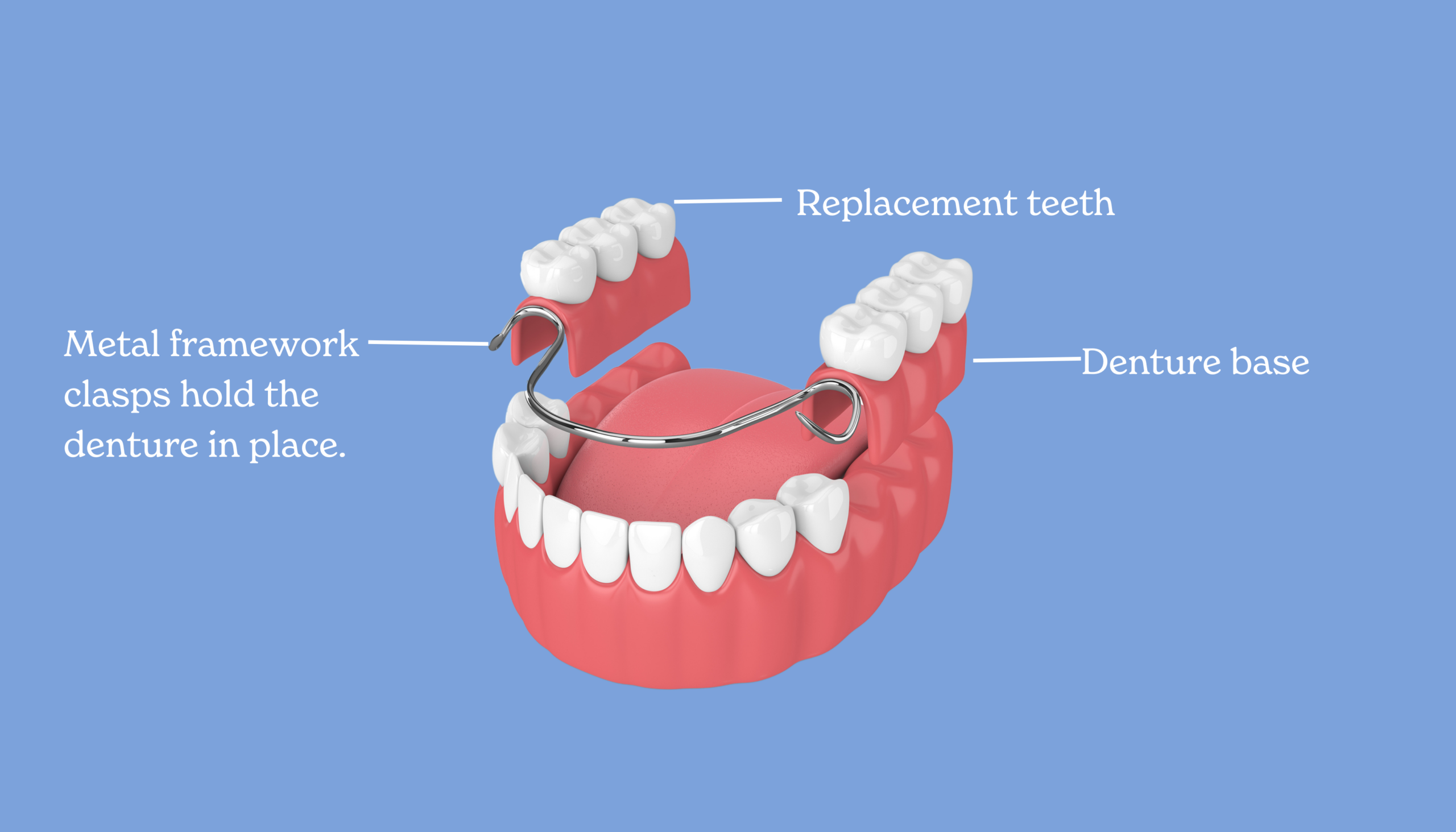Partial Dentures
Partial dentures can be a cost-effective tooth replacement option for patients who have lost more than one tooth or haven’t had some teeth come in. Often held in place by clasps around your existing teeth, dentures are one of the most secure ways to fill gaps left by teeth that need replacing.
Book a general exam with your dentist today and discover what cosmetic treatments are available to you.

Compare cosmetic dental options
| Purpose | Advantages | Disadvantages | Lifetime | Procedure | Material | Cost | |
|---|---|---|---|---|---|---|---|
| Partial Dentures | Tooth replacement option for patients who have lost more than one tooth or haven’t had some teeth come in. | Can be temporary or permanent for people of all ages. One of the most secure ways to fill gaps left by teeth that need replacing. | Require special care and cleaning to avoid bacteria build-up. Dentures need to be replaced every few years as they wear down and no longer fit as well as they did. | On average, partial dentures can last between 5 and 10 years. | Partial dentures made will generally require up to 4 appointments. Your dentist will take impressions of your mouth. Once the denture is made, they will test fit them to make sure it is comfortable, and the way it feels and looks. | Will often use chrome framework instead of acrylic framework as it can offer more stability and strength. | Generally made of acrylic resin or porcelain. You may have the option of getting porcelain dentures, which last longer; however, acrylic dentures are usually stronger. |
| Full Dentures | A full denture can restore function when all of the teeth have been lost due to disease or damage. They help provide support to the facial structure allowing lips and cheeks to look fuller, resulting in a younger, healthier appearance. | A cost-effective tooth replacement option for more than one tooth or those that haven’t had some teeth come in. Available for both the lower and upper jaws. Option to have implant retained dentures, held in place by dental implants secured within the jaw. | Require special care and cleaning to avoid bacteria build-up. Dentures need to be replaced every few years as they wear down and no longer fit as well as they did. | On average, full dentures can last between 5 and 10 years. | Full dentures generally require up to 5 appointments. Your dentist will examine your mouth to determine if dentures are suitable for you and will take impressions of your mouth. They will also test fit your denture to make sure it is comfortable, and you like the way it feels and looks. | Will often use chrome framework instead of acrylic framework as this offers far more stability and strength. | Generally made of acrylic resin or porcelain. You may have the option of getting porcelain dentures, which last longer; however, acrylic dentures are usually stronger. |
FAQS
Partial dentures can be a cost-effective tooth replacement option for patients who have lost more than one tooth or haven’t had some teeth come in. These can be temporary or permanent for people of all ages and will often use chrome framework instead of acrylic framework as this offers far more stability and strength. Often held in place by clasps around your existing teeth, dentures are one of the most secure ways to fill gaps left by teeth that need replacing.
Replacing missing teeth will make eating and speaking easier and provide you with a more confident smile no matter the position of the teeth.
Dentures are typically made of acrylic resin (plastic) or a lightweight metal (mainly cobalt chrome) and are designed to look as similar to your natural teeth as possible, making them almost unnoticeable. Not only do dentures improve the appearance of your smile, but they also resolve any facial sagging caused by missing teeth and help to fill out the cheeks and lips.
As your tongue and mouth get used to your new dentures, eating may take some practice at first. Your dentist or prosthetist may suggest beginning with softer foods cut into small pieces, and ensuring you chew with both sides of your dentures at the same time to avoid any movement.
Eventually, you will feel comfortable returning to your normal diet, but it is important to remain cautious with hot or hard foods and sharp bones or shells.
Your dentist or prosthetist will recommend that you remove your dentures at night to give your gums, bones, and other denture-bearing tissues a chance to recover.
Dentures or tooth replacements in general will prevent other teeth from shifting and causing misalignment. Partial dentures can be a good choice as they support the existing natural teeth and gums and don’t require any invasive surgery.
Having partial dentures made will generally require up to 4 appointments.
Step 1: An examination with your dentist or prosthetist will help to determine if partial dentures are a suitable option for you.
Step 2: Your dentist will take impressions of your mouth.
Step 3: Your dentist will test fit your partial denture to make sure it is comfortable and you like the way it feels and looks. Any changes can be still made at this stage before the denture is sent to the laboratory for finishing.
Step 4: The dentist will do a final check and make any minor adjustments to ensure your denture is comfortable, is functional, and looks good.
If you are missing multiple teeth, your dentist can help to determine the most suitable tooth replacement option for you based on your current dental health and suitability for the procedure.
It is important to take proper care of partial dentures as they can increase the risk of plaque accumulation around the support teeth and gum line. Plaque build-up can often lead to tooth decay and gum disease so it’s important to ensure you are cleaning them properly and attending your regular check-ups.


